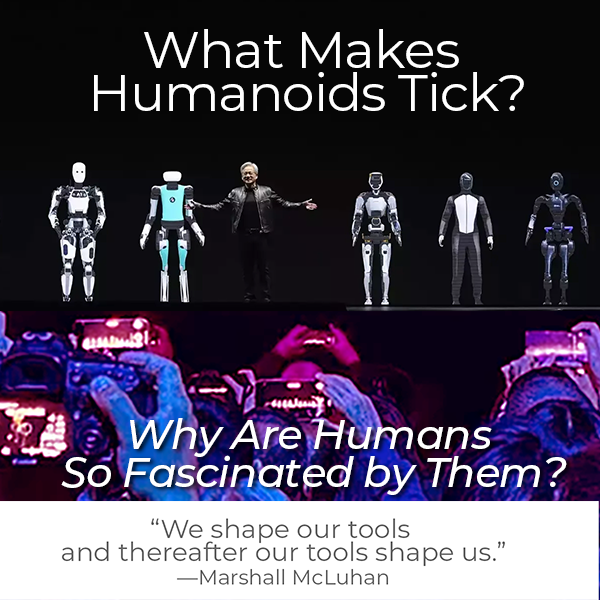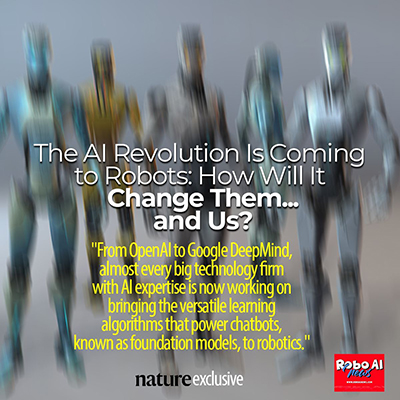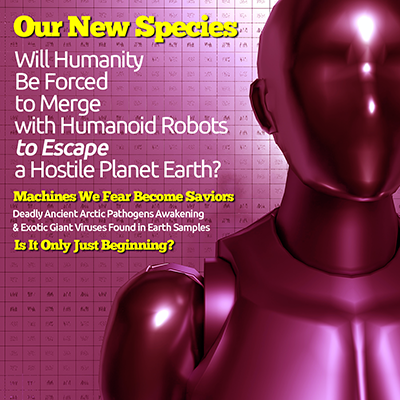
Why Humanoids Are a Very Big Deal These Days
Robotics is quickly approaching a “ChatGPT moment”
—Jensen Huang, CEO NVIDIA
“Unlike traditional robotics, which required painstakingly detailed programming and training, AI-powered robots can learn and adjust on the go. This adaptability is a game-changer, enabling robots to perform a wider variety of tasks with increased competence and autonomy, thus expanding their potential applications across industries.”
— Mariya Yao, TOMBOT
Humanoids arise!
Unskilled at shaping human forms from a pile of clay and a rib, the children of Eden finally succeeded in replicating themselves—sort of— using metal, wiring, and batteries. Standing upright, able to ambulate, and take direction, their creators called them humanoids, and then set about trying to find useful things for these humanoids to do.
For decades they were stumped at finding anything practical for the bipeds to do other than appearances in movies and TV. For example, Honda’s biped humanoid ASIMO was a Gen Zer born in 2000, and after twenty-four years was underwhelming as a useful robot. Well, Honda did mercifully can ASIMO in 2018, so hopefully, lessons learned will go far on any future bipeds.
Times have changed! Six years after ASIMO was signed into the old age home where he once was attempting to be an employee, humanoids are on a roll at earning respect for actually doing work.
See related:
Artificial intelligence and robotics could catapult both fields to new heights
A bunch of them are laboring at a SPANX warehouse in Georgia, looking awkward at moving totes filled with “slimming intimates, body shapers, hosiery, apparel, and the latest innovations in shapewear for men and women,” (according to SPANX. Named Digit from Agility Robotics, they work for $30 per hour with an ROI in two years, says Agility (see video).
Globally, there are over a dozen other humanoids all readying for some sort of job somewhere…even in a BMW plant. During a two-week pilot at a plant in Spartanburg, South Carolina, the new Figure 02 humanoid from Figure AI successfully fitted sheet metal parts into precise fittings that were then assembled as part of a car chassis.
Seems everything in the humanoid ecosystem has been working at double time ever since Elon Musk introduced his upcoming humanoid, named Optimus (scheduled to go on sale in 2026). He shook up the industry again this year claiming that he’ll manufacture one billion of the humanoids yearly!
So, what is going on with these humanoids that’s seeing so much progress being made by their developers?
Mariya Yao is here to explain what makes these humanoids tick. Mariya, as many of you know, is editor-in-chief, CTO, and Head of Research & Design at TOPBOTS, which guides Fortune 500 companies and executives on AI trends, strategy, and adoption. Plus, she’s super at clearly and interestingly explaining what’s happening in AI and robots.
by Mariya Yao
Mariya explains it all
There’s a humanoid revolution going on she says. The core of this revolution is the use of neural networks to create versatile robotic “brains” that enable robots to tackle various tasks much like humans do.
Major players in the field have opted to build “humanoids,” designing their robots to mimic human form and size.
Why? Since our world is inherently designed for humans, with nearly everything around us built with human dimensions and capabilities in mind, seems to be a logical and efficient strategy to develop humanoid robots that can seamlessly navigate and operate within this human-centric environment.
Recent breakthroughs in imitation learning, combined with the power of generative AI [GenAI], are accelerating the pace of innovation. Imitation learning allows robots to learn complex tasks by observing human actions, while generative AI enhances the training process by creating vast amounts of synthetic data. Moreover, the decreasing cost of hardware components has removed one of the significant barriers to entry, making it more feasible to develop sophisticated robotic systems.
Opportunities in Humanoid Robotics
The rapid advancements in humanoid robotics are being driven by several favorable factors, each contributing to a landscape ripe with opportunity. From the decreasing costs of hardware to the innovative application of AI in building robotic brains, these developments are not only accelerating research but also making the widespread deployment of humanoid robots increasingly feasible. Below, we explore four key opportunities shaping the future of humanoid robotics.
- Affordable Hardware Enables Broader Research
One of the most significant drivers of progress in humanoid robotics is the decreasing cost of essential components. The price of manufacturing humanoid robots has dropped considerably, making advanced robotics research more accessible to a broader range of institutions and companies. Just a year ago, the cost of producing a humanoid robot ranged from $50,000 to $250,000 per unit. Today, that range has narrowed to between $30,000 and $150,000.
- AI-Powered “Robot Brains” Revolutionize Capabilities
The integration of AI, particularly generative AI, into robotics has shifted the focus from mere physical dexterity to the development of sophisticated “robot brains.” These neural networks function similarly to the human brain, controlling various aspects of the robot’s behavior and allowing it to adapt to different scenarios and tasks. Unlike traditional robotics, which required painstakingly detailed programming and training, AI-powered robots can learn and adjust on the go. This adaptability is a game-changer, enabling robots to perform a wider variety of tasks with increased competence and autonomy, thus expanding their potential applications across industries.
- Imitation Learning Enhances Skill Acquisition
Imitation learning, a technique where robots learn by mimicking human actions, has gained renewed attention in the robotics community. This method involves using virtual reality or teleoperation to teach robots complex tasks by example, a process that is proving particularly effective in manipulation tasks. The resurgence of this technique is largely due to its compatibility with the latest AI advancements, particularly in generative AI. By leveraging imitation learning, researchers can extend the principles of AI beyond text, images, and video into the realm of robot movement, opening up new possibilities for teaching robots a broad range of skills in a more intuitive and efficient manner.
Digit Punches In at SPANX
- Generative AI Expands Training Data Availability
One of the longstanding challenges in robotics has been the scarcity of high-quality training data. Generative AI offers a powerful solution to this problem by creating vast amounts of synthetic data that can be used to train robots. With the ability to generate relevant visual scenarios and other forms of data, AI enables researchers to simulate a wide variety of environments and situations, thereby providing robots with the diverse experiences needed to learn new skills.
While these opportunities are driving significant progress in humanoid robotics, there remain critical challenges that need to be addressed to fully unlock the potential of this technology. Let’s explore these in the next section.
Challenges in Humanoid Robotics
While the progress in humanoid robotics is promising, several significant challenges remain that must be addressed to achieve widespread adoption and integration. These challenges span technical, economic, and ethical domains, highlighting the complexity of developing and deploying humanoid robots at scale. Below, we outline seven key challenges currently facing the field.
- High Development and Maintenance Costs
Despite recent reductions in component costs, humanoid robots remain expensive, posing a barrier to mass adoption and commercialization. The development and ongoing maintenance of these advanced systems require substantial financial investment. For many potential users, especially in smaller industries or research institutions, the cost of acquiring and maintaining humanoid robots is still prohibitively high.
- High Energy Demands
Bipedal robots are notoriously energy-intensive, requiring efficient power systems and advanced energy management to operate effectively. The high energy demands limit the runtime of these robots, restricting their usefulness in many applications. Although advancements in battery technology offer potential solutions, current battery life of up to 5 hours still falls short of what is needed for extended, continuous operation.
- Limited Supply of Critical Components
The production of humanoid robots is also constrained by the limited availability of certain critical components. High-precision components, such as those requiring specialized grinding machines, are difficult to source in large quantities due to limited industrial capacity or long manufacturing cycle times. This bottleneck not only keeps costs high but also hinders the ability to scale production to meet potential demand.
- Human-Robot Interaction
Effective human-robot interaction remains a challenging area, particularly when it comes to natural language processing and intuitive command interpretation. For instance, enabling robots to reliably take voice commands from a person without prior training is a significant hurdle. Developing more sophisticated AI systems that can understand and respond to a wide range of human inputs, including nuanced voice commands, is vital for making robots more user-friendly and accessible in everyday environments.
- Precise Control and Coordination
One of the technical challenges that continue to limit the functionality of humanoid robots is their ability to perform precise control and coordination tasks. For example, while Figure 02 boasts 16 degrees of freedom in its hands, this is still far less than the 27 degrees of freedom found in a human hand. This limitation affects the robot’s ability to perform delicate and complex tasks, such as grasping and manipulating objects.
- Limited Perception of the Surrounding World
Humanoid robots rely heavily on cameras and sensors to perceive their environment, which can limit their understanding and responsiveness. These sensory systems, while advanced, still fall short of the human ability to intuitively understand and interact with complex, dynamic environments.
- Legal and Ethical Issues
As humanoid robots become more integrated into society, legal and ethical considerations are increasingly coming to the forefront. Questions around liability, privacy, and the potential displacement of human workers are significant concerns that need to be addressed. Moreover, developing regulations that govern the lawful and ethical use of robots will require interdisciplinary collaboration among technologists, ethicists, and policymakers. Ensuring that the advancement of humanoid robots is responsible and aligned with societal values is essential for their long-term acceptance and success.
Despite the significance of these challenges, they are not insurmountable. With continued innovation and collaboration across the industry, these obstacles can be addressed, paving the way for humanoid robots to become a common presence in both commercial and everyday settings. See TOMBOT: Several major players are already competing to build the first truly mass-adoptable humanoid robots, each pushing the boundaries of what’s possible.
In the Future, How Close
Will We Get to Humanoids?



